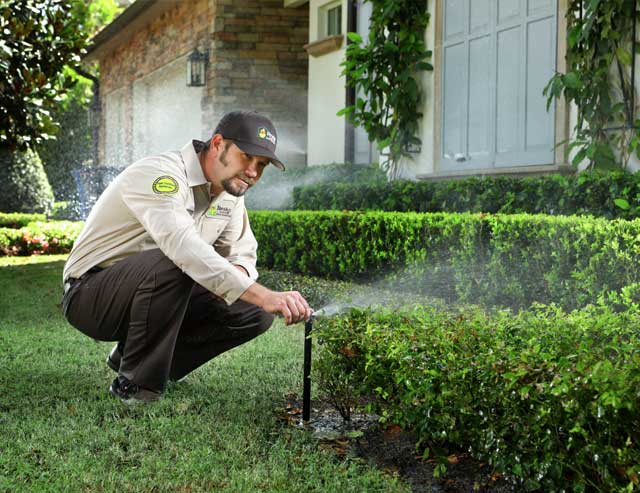Watering Your Florida Lawn
All plants require water for metabolic and physiological functioning. Although some plant species are large consumers of water, other species can be maintained with relatively low quantities of water. Many people consider turfgrasses to be large water consumers, but many turf species have excellent drought tolerance mechanisms. Bahiagrass, for example, can survive for long periods of time with virtually no water. In drought periods, bahiagrass will go into a dormant stage, during which time shoot tissue will become chlorotic or necrotic. Upon resumption of adequate rainfall, however, bahiagrass will resume growth and become green again.
What Water Does in Plants
Water combines with light and carbon dioxide in the process of photosynthesis, which provides the plant with carbon needed for growth and storage.
Water flows from the roots to the top of plants in a process called transpiration, which provides the plant with a cooling mechanism.
Water in the soil solution helps move mineral nutrients to the plant roots for absorption.
Imbibing water is the first step in seed germination.
A well-irrigated grass plant is better able to withstand pressure from weeds and insects.
A well-irrigated grass plant is better able to withstand environmental stresses such as wear, high temperatures, soil problems, or nutrient deficiencies.
Although water is important in maintaining a healthy lawn, the majority of homeowners over irrigate or irrigate incorrectly. Too much water is damaging to turfgrass and is often the underlying cause of lawn failure. Problems with overwatering include:
A less developed and shorter root system, which has less capacity to seek out water and nutrients at lower soil depths and has less overall stress resistance
An overly succulent shoot system, susceptible to disease and insect infestation.
Weaker cell walls in the shoot tissue, which reduce the strength of leaf tissue.
Buildup of excessive thatch, particularly in St. Augustinegrass.
When developing an irrigation plan, it is essential to consider the following:
- How frequently to water
- How much to water
- Time of day to water
- How to uniformly apply water
- How your turf irrigation affects your landscape plants
- Any microenvironmental effects in the landscape that affect irrigation requirements
How Frequently to Water
Irrigation of many Florida lawns is controlled by a preset automatic sprinkler system. While automation is becoming increasingly necessary in many areas of our lives, automatic sprinkler systems and improper watering practices are undoubtedly the single biggest factor leading to decline of home lawns. It is important to remember that, on average, we receive 60 or more inches of annual rainfall in most parts of Florida, and that the majority of this rainfall occurs between June and October. When rainfall is adequate to meet the plants transpiration needs, supplemental irrigation systems should be turned off. How do you know what the grass transpiration needs are? University of Florida guidelines call for watering lawns on an “as-needed” basis. This can be determined by observing the grass for signs of drought, which indicate that transpiration needs are not being met. The signs that you need to look for are:
Leaf blades are folded in half lengthwise in an attempt to conserve water.
The grass takes on a blue-gray tint rather than maintaining a green color.
Footprints or tire tracks remain visible on the grass long after being made.
When these signs of drought are seen on a large portion of the lawn, its time to irrigate. The length of time needed between irrigations will vary depending upon grass species, soil characteristics, location in the state, time of year, temperatures, and any particular microenvironmental effects such as shade. If rain is forecast in the next two days, delay irrigation.
How Much to Water
The amount of water to apply at any one time varies with the amount of water present in the soil, the water-holding capacity of the soil, and soil drainage characteristics. An efficient watering wets only the turfgrass root zone, does not saturate the soil, and does not allow water to run off.
Florida soils are typically sandy and hold 1 inch of water in the top 12 inches of soil. If the roots are in the top 12 inches of soil and the soil is dry, then ½ to ¾ inch of water is required to wet the area thoroughly. Generally, turfgrasses require no more than 0.3 inches of water per day. Under extreme summer conditions, as much as 0.4 inches of water can be used per day. During winter, when grasses are not actively growing, water use may be only 0.05 inches of water per day. Light, frequent watering is inefficient and encourages shallow root systems. Excessive irrigation, which keeps the root system saturated with water, is also harmful to the lawn.
A simple watering schedule would apply ¾ inch of water when the turfgrass shows water deficit symptoms as discussed earlier. Once this ¾ inch of water is applied, do not apply any more until water symptoms are again noticeable. With no rainfall, 2 to 3 waterings per week in the summer and once every 10 to 14 days in the winter are adequate. If rainfall occurs, irrigation should be suspended until visible drought symptoms appear.
When to Water
The best time for lawn irrigation is in the early morning hours. Watering during the day wastes water due to excessive evaporation and can scald the lawn when temperatures are high. Watering in late afternoon or late morning may be detrimental if it extends the time the lawn is naturally wet from dew. This extended “dew period” can accelerate disease occurrence.
How to Uniformly Apply Water
Irrigation system installers are licensed in some Florida counties, while in other counties there is no regulation of installation at all. This may lead to inefficient or sloppy installation, resulting in water waste and non uniform coverage of turf areas. Even with a professionally installed system, it is important to check coverage on a regular basis, as heads may become clogged, damaged, or off-center, and leaks in the line may occur. An easy way to routinely check your irrigation system is to place small, straight-sided cans in a straight line from your sprinkler to the edge of the watering pattern, and look for uniformity of coverage. If an area is not receiving water from one or more heads, or if a head is not providing complete coverage, dry spots can develop. This can lead to any of the problems associated with drought-stressed turf. While checking uniformity with the coffee can method, you can also easily determine how long it takes your system to apply ½ to ¾ inch of water. Turn the water on for fifteen minutes and calculate the average depth of water in the cans. Multiply this number by four to determine the irrigation rate in inches per hour.
While checking for damaged sprinkler heads, replace any that are leaking or not providing uniform coverage. Also, check to ensure that valves open and close properly.
How Your Turfgrass Affects Your Landscape Plants
It’s important to remember that a sprinkler zone may be irrigating not only turf, but landscape plants as well. These plants may have different irrigation requirements and may be over- or under watered if irrigation is based on turfgrass needs. This factor emphasizes the importance of good landscape design and irrigation planning, where all components of the system must be considered.
Any Micro-Environmental Effects in the Landscape that Affect Irrigation Requirements
Not every part of your lawn will have the same irrigation requirements. For instance, if grass is planted close to the house, it will be in shade for some portion of the day. Trees or large shrubbery can also cause shade, and some mature canopies actually shade a portion of the lawn for an entire day. In these cases, it may be very difficult to grow an acceptable stand of turf, and a different groundcover may be a better choice. If you choose to grow grass in the shade, you must reduce irrigation to this part of your lawn.
Brandon is the President of Drake Lawn and Pest Control in Orlando, FL . He has over 30 years experience in the Orlando Pest Control Industry. He attributes his achievements to living by these rules: continuous training and education, providing honest work and striving for the pursuit of perfect service.



